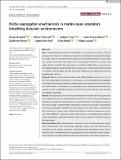Niche segregation mechanisms in marine apex predators inhabiting dynamic environments
Abstract
Aim: Understanding the mechanisms that allow the coexistence of species is key to preserve full ecosystem functioning. In dynamic environments, the study of ecological niches faces the complexity associated to the three dimensionality of the habitat and requires information that reflects such heterogeneity. Within this context, this study intends to identify the segregation mechanisms behind the co-occurrence of five phylogenetically related pelagic birds by applying a functional perspective based on seabirds' vertical ranges and prey availability features such as depth and body size. Location: Bay of Biscay. Methods Based on the hypothesis that niche differentiation may occur in any of the three dimensions of the marine environment, we (a) identified the biologically meaningful vertical range affecting seabird species, (b) modelled their environmental and trophic niches, (c) estimated an environmental and trophic overlap index for each pairwise species, and (d) developed a conceptual framework with the most plausible segregation hypotheses. Results: The application of the conceptual framework revealed that in this particular area, pelagic birds coexist through environmental and trophic niche partitioning and potentially through vertical segregation, based on the different biologically meaningful vertical ranges we identified for each species. Indeed, some species responded to prey and oceanographic conditions on the surface (10 m), while others responded to the conditions on deeper waters (above the depth of maximum temperature gradient). These different responses could be interpreted as an additional mechanism to reduce competition, although seabirds diving records would be needed to contrast this hypothesis. Main conclusions: Niche differentiation was found to be primarily driven by trophic and environmental niche partitioning, although species were also influenced by conditions on the vertical dimension. Considering all the dimensions of the niche is essential to fully understand how diving seabirds coexist in dynamic systems and provides insights on species' 3D niches that may help advance into their management.
Citation
Astarloa , A , Glennie , R , Chust , G , García-Baron , I , Boyra , G , Martínez , U , Rubio , A & Louzao , M 2021 , ' Niche segregation mechanisms in marine apex predators inhabiting dynamic environments ' , Diversity and Distributions , vol. Early View . https://doi.org/10.1111/ddi.13229
Publication
Diversity and Distributions
Status
Peer reviewed
ISSN
1366-9516Type
Journal article
Description
The JUVENA survey was funded by the ‘Viceconsejería de Agricultura, Pesca y Políticas Alimentarias ‐ Departamento de Desarrollo Económico y Sostenibilidad y Medio Ambiente’ of the Basque Government, the ‘Secretaría General de Pesca, Ministerio de Agricultura, Alimentación y Medio Ambiente’ of the Spanish Government and by the Spanish Institute of Oceanography (IEO). This research was funded by the Spanish Government (Ministry of Science and Innovation) through the CHALLENGES (CTM2013‐47032‐R) and the EPELECO (RTI2018‐101591‐B‐I00) projects, the Basque Government (‘Viceconsejería de Agricultura, Pesca y Políticas Alimentarias ‐ Departamento de Desarrollo Económico, Sostenibilidad y Medio Ambiente’) through the ECOPES project as well as the Horizon 2020 programme of the European Commission (Contract No. 862428, Atlantic Mission: Mapping and assessing present and future status of Atlantic marine ecosystems under climate change and exploitation). A.A. has benefited from a Basque Government scholarship (PRE_2016_1_0134) and M.L. from Ramón y Cajal funding (Ministerio de Ciencia e Innovación, RYC‐2012‐09897). Special thanks are given to the crew on board R/V Emma Bardán and R/V Ramón Margalef and all the AZTI and Spanish Institute of Oceanography (IEO) staff who participated in JUVENA surveys for their excellent job and collaborative support. This paper received contribution nº 1013 from AZTI, Marine Research, Basque Research and Technology Alliance (BRTA).Collections
Items in the St Andrews Research Repository are protected by copyright, with all rights reserved, unless otherwise indicated.

